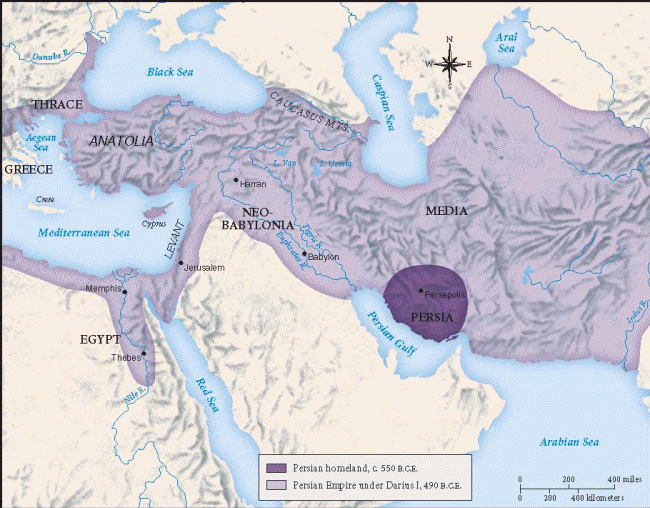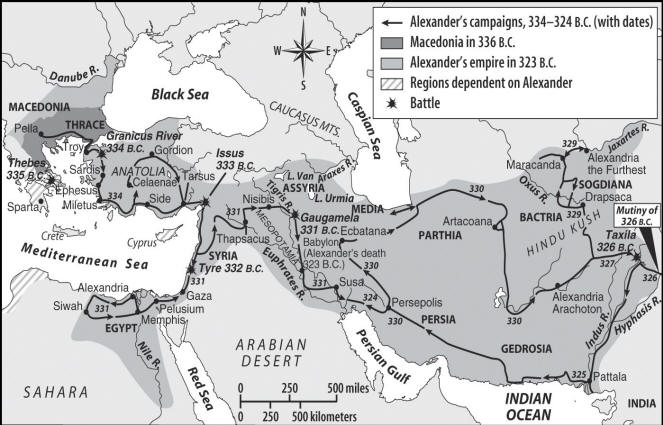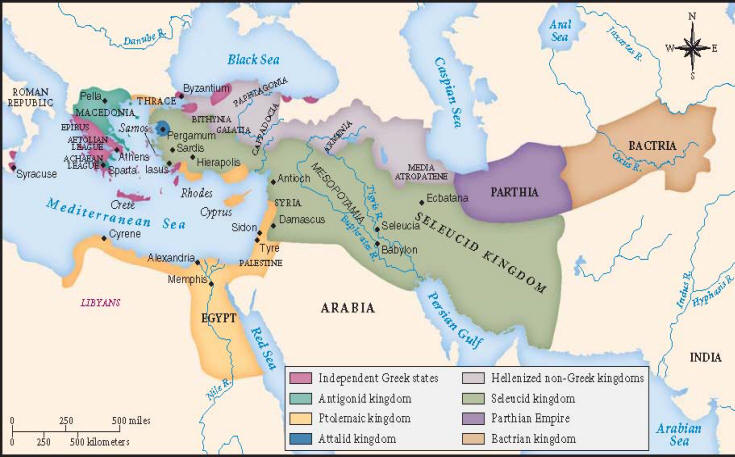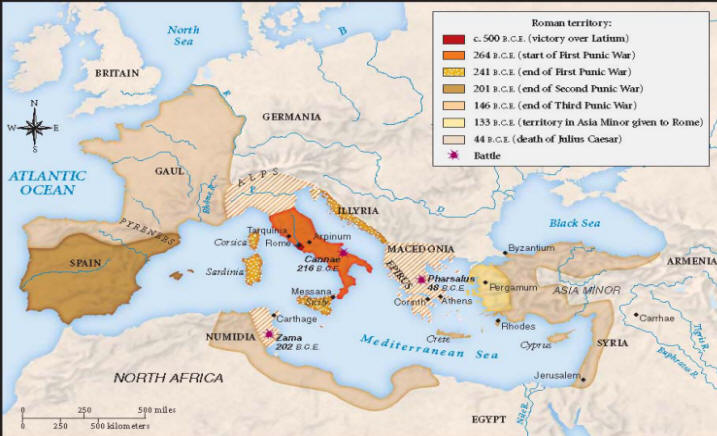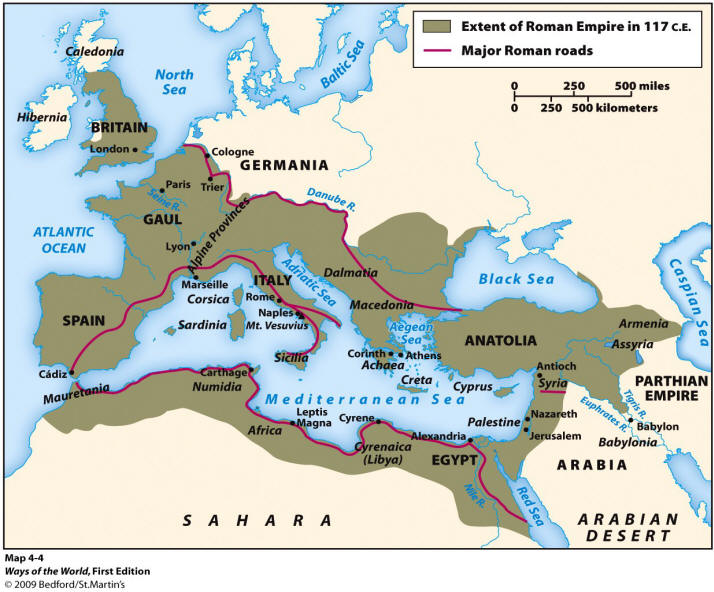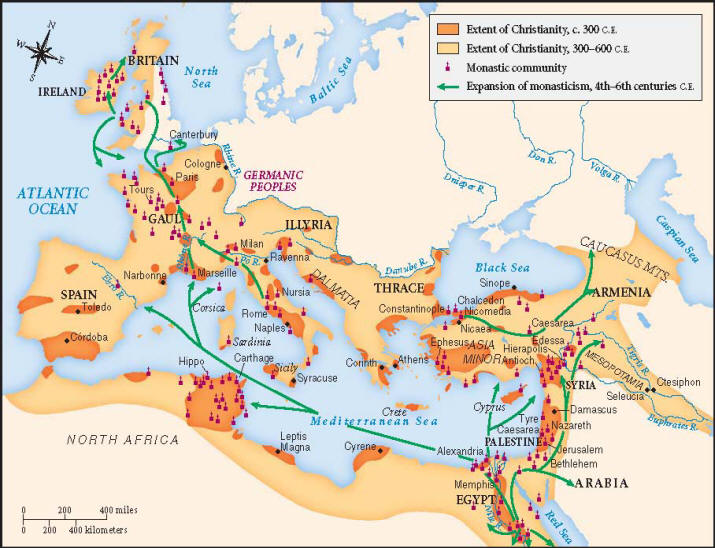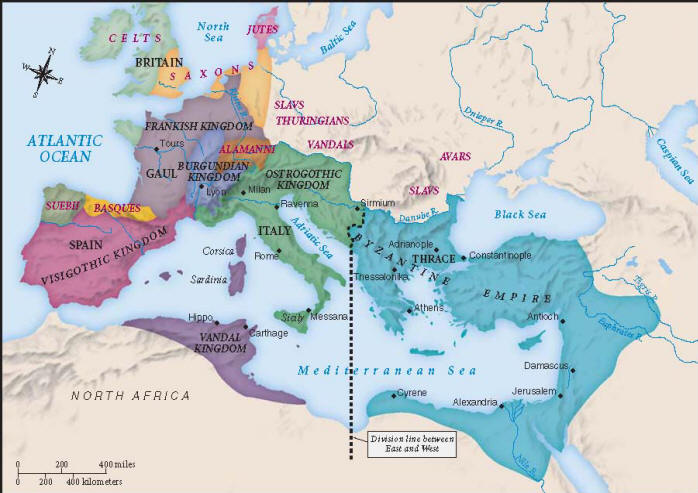Maps 2: History - Ancient Period
HUM 213 Historical Overview
URL of this web page:
http://web.cocc.edu/cagatucci/classes/hum213/Maps/Maps2HistoryAncient.htm
Ancient Middle East & Mesopotamia
| Map 1.1 "The Ancient Near East, 4000-1000 B.C.E." |
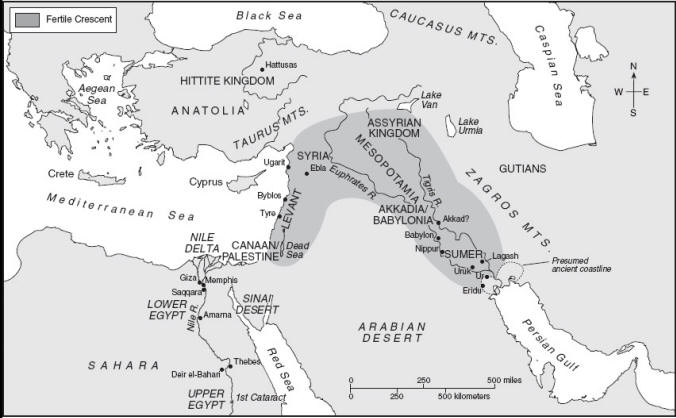 |
|
c. 8500 - 8000 BCE |
"[D]omestication of wild plants and animals was accomplished in Mesopotamia around 8500 B.C.E., well before any other nascent civilization" ("Mesopotamia: The Formation of Cities and the Earliest Literatures"; emphasis added). According to recent archeological evidence, ". . . people living near the present-day city of Jericho near the Dead Sea were some of the first human beings to practice agriculture,” and “Signs of equally ancient town life have been found at a place called Catal Huyuk in [present-day] Turkey” [Anatolia], where people may have “first practiced irrigation and domesticated animals” (Kort 7; emphasis added). |
|
c. 4000? BCE Great Flood stories |
Archeological evidence was found (in 1929) of a possible great flood “at Ur, near the Persian Gulf, in the delta of the Tigris and Euphrates Rivers” (Davis and others [Book 1] 21; emphasis added). “Stories of a great flood or deluge often seen as a warning or punishment have appeared in all parts of the world except Africa": for example, stories of a great flood appear in the Epic of Gilgamesh, ca.1800 BCE; and in the later Hebrew Book of Genesis, ca. 900 BCE (Davis and others [Book 1] 21; emphasis added). |
|
c. 3500 - 3000 BCE |
Thriving cities were established in Mesopotamia along the Tigris-Euphrates Rivers, and in Egypt along the Nile River (Davis and others [Book 1] 2). The Middle East is not all desert: "Rivers allowing for productive agriculture were the key factor in the settling of cities" beginning some 6,000 years ago ("Geography: An Ancient and Modern Crossroads"). In the "Fertile Crescent" (the crescent-shaped region shaded in Maps 1.1 and 1.3), the Tigris and Euphrates River waters enabled the Sumerians of ancient Mesopotamia to develop the "world's first urban culture"; meanwhile, in Egypt (see Map 1.2) the ancient Egyptians "took advantage of the annual flooding of the Nile [River] for their regular harvest" ("Geography: An Ancient and Modern Crossroads"). "When Egypt was united" circa 3100 BCE, the world had its first political unit large enough to be called a country” (Kort 7). Mesopotamia''s strategic location at the crossroads of developing trade routes, "documented from as early as 5,000 years ago" ("Geography"), contributed to Mesopotamia's prosperity, cultural diversity, and history of warfare. |
| Map 1.2 "Ancient Egypt" |
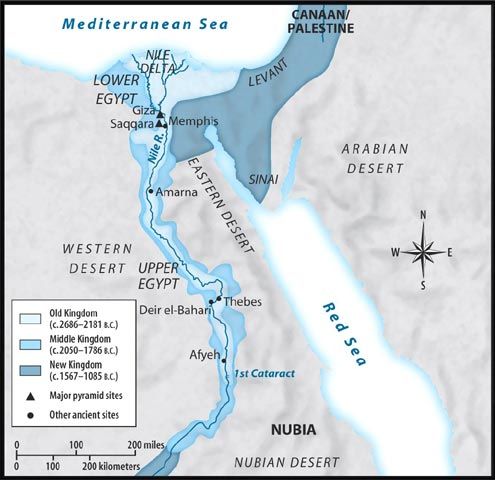 |
|
[Map Caption:] "Like the people of Mesopotamia, the Egyptians took advantage of a water source, the Nile River, to irrigate arid land and produce a surplus of food. The river also acted as a highway for traveling north to the Mediterranean and south to Nubia" ("Ancient Egypt." [Map.]; emphasis added). |
|
c. 3500 - 2300 BCE |
Sumerian urban culture centered in Sumer [in what is now modern day Iraq], and Sumerian accomplishments included using the wheel, advancing mathematics (e.g. for measuring time), and creating “the world’s first writing system” - cuneiform - to “keep records of what they did," thus beginning written human “history” (Kort 7). Many migrating peoples entered the region, some as peaceful settlers, others as invaders intent on conquest. Mesopotamia "must be seen as one of the first significant multilingual, multicultural societies in history, with its 3,000 years of development and no less that four major periods under different ruling groups (Sumerian, Babylonian, Assyrian and Persian)" ("Mesopotamia: The Formation of Cities and Earliest Literatures"). |
|
c. 2600? BCE Gilgamesh |
Gilgamesh, epic hero and legendary king of Uruk--a Sumerian city located on the Euphrates River in southern Mesopotamia (see Map 1.3)--“is apparently based on a historical figure . . . [whose name is] "found in the lists of Sumerian kings" and who may have "reigned in the city of Uruk . . . sometime between 2800 and 2500 B.C.E." (Davis and others [Book 1] 2, 56). |
|
c. 2300 - 2000 BCE |
The Akkadians,
“a Semitic
people [originally] from the interior of the Arabian peninsula,”
conquered “the non-Semitic Sumerians” of
Mesopotamia, led by Akkadian King Sargon I (born 2337? - died 2279? BCE), who is credited with establishing “the first known empire in history—stretching from the Persian Gulf to the Mediterranean Sea” (Davis and others [Book 1] 17; emphasis added). However, Sargon's united Akkadian empire did not long survive his death, and was subsequently divided into the kingdoms of Babylonia (southern Mesopotamia), Assyria (northern Mesopotamia), and "Elam (Persia) to the east [of Mesopotamia]" (Davis and others [Book 1] 18; emphasis added). See Map 1.3. |
|
c. 2100 - 1600
BCE:
Epic of Gilgamesh |
Heroic stories of legendary Sumerian king Gilgamesh, passed down from oral tradition, were written down in “cuneiform on clay tablets” by Mesopotamian poets and were eventually shaped into the Epic of Gilgamesh, "the most influential literary epic to come out of ancient Mesopotamia," though only fragments of this epic have been recovered to date (Davis and others [Book 1] 62). |
| c. 1750 BCE | Babylonian King Hammarabi--known for the Code of Hammarabi, one of the world's first written set of laws--united much of Mesopotamia during his reign (r. 1792-1750 BCE) and established his capital at Babylon (Davis and others [Book 1] 18). See Map 1.3. Babylon [ruins located south of Baghdad in modern Iraq], a “chief commercial city of the Tigris and Euphrates river system,” became “one of the most famous cities of antiquity,” achieving its “greatest glory as capital of the Neo-Babylonian empire under Nebuchadezzer II (r. 605-561 BCE)” (“Babylon”). |
| Map 1.3 "The Ancient Near East" |
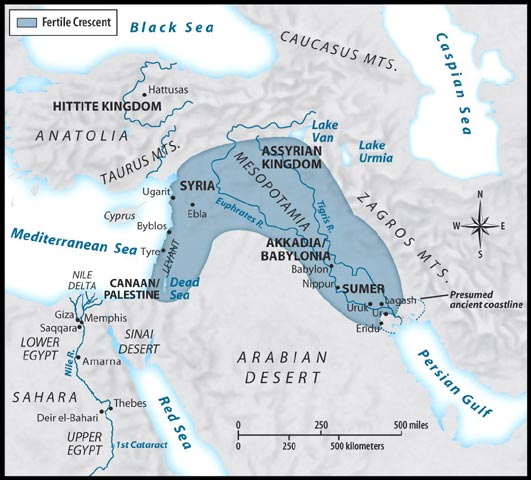 |
|
[Map Caption:] "The region of the Near East between the Tigris and Euphrates Rivers, called Mesopotamia, is thought to be the birthplace of civilization--non-nomadic societies characterized by agriculture and cities. The inhabitants of Mesopotamia raised crops on this rich but dry land by developing and using complex irrigation systems so successful that they resulted in a surplus of food" ("The Ancient Near East." [Map.]; emphasis added). |
Early Hebrew History (ca. 2000 - 586 BCE)
|
c. 2000 BCE Abraham Monotheism |
"According to Hebrew Scriptures, Abraham, the first patriarch, came from Ur of the Chaldees, an ancient city in Mesopotamia” and led his people on a journey “into the southern portion of Canaan (the land of Palestine)” (Davis and others [Book 1] 136; emphasis added). See Maps 1.1 and 1.3. "Judaism is the oldest surviving monotheistic religion" (Monotheism is the belief that there is only one ultimate God), and "Abraham is traditionally considered to be the first Jew and to have made a covenant with God. Because Judaism, Christianity, and Islam all recognize Abraham as their first prophet, they are also called the Abrahamic religions" ("Religion: Three Religions, One God"). |
|
c. 1500 - 1300 BCE |
During the Hebrew "Age of the Patriarchs" (e.g. Abraham, Isaac, Jacob, and Joseph), "nomadic tribes of Hebrews [who] followed the Fertile Crescent [Mesopotamia] southward through Palestine to Egypt," were "enslaved by the Egyptians sometime between c. 1500-1300 B.C.E." (Davis and others [Book 1] 127; emphasis added). See Maps 1.3 and 1.2. |
|
c. 1250? BCE Moses and the Exodus |
“Hebrews’ Exodus from Egypt” [the word Exodus means "going out"] and “conquest of Canaan” [AKA: Palestine] (Davis and others [Book 1] 3, 162; emphasis added). “The Book of Exodus describes the emergence of the extraordinary leader Moses, the historical founder of Judaism and the person primarily responsible for the transition of the Hebrew people from a tribal to a national culture” (Davis and others [Book 1] 136; emphasis added). |
| Moses & the Ten Commandments | “According to Hebrew Scripture, [the one and only] God (referred to by the letters YHWH and known as Yahweh) reveals himself to Moses,” divinely inspiring Moses to free “his people from slavery” in Egypt; to lead them across the Sinai Desert to Mt. Sinai, where the foundational Ten Commandments are revealed; and to invade, conquer, and settle “the land of Canaan (also known as Palestine)” (Davis and others [Book 1] 127-128; emphasis added). |
|
c. 1200 - 1030 BCE |
The Hebrew "Period of Judges" was a “time of warfare, when Hebrew military leaders, called judges,” defended and helped unify Jewish groups in the land of Canaan/Palestine (Davis and others [Book 1] 4, 127-128; emphasis added). |
|
c. 1000 BCE Hebrew Writing & Literature |
Hebrew, classified as belonging to the Canaanite branch of Semitic languages, was the common spoken tongue of the early Jewish people ("Hebrew Language"). "The Hebrews adopted a version of the Phoenician [writing] system” (developed circa 1200 BCE) to begin recording “their literature, a collection of myths, folk tales, history, poetry, drama, short stories, biographies, philosophy, and prophecies. This [early writing] system was later replaced by a newer [Hebrew] script called ‘square writing,’ after the square shape of its letters” (Davis and others [Book 1] 132. |
|
c. 1000 - 922 BCE |
Legendary Hebrew kings David
and Solomon reigned
(Davis and others [Book 1] 4). --King David is credited with creating the kingdom of Israel, “the first nation the Hebrews could call their own,” after “fighting his father [King Saul] over the rule of the states of Israel and Judah” and unifying the “disparate Hebrew tribes” of early Palestine (Davis and others [Book 1] 133). --King Solomon's reign (circa 960-922 BCE), called the "Golden Age of Israel," was “a time of peace and prosperity,” during which “the Israelites fortified their cities and built a magnificent temple in Jerusalem, where worship of Yahweh was centered” (Davis and others [Book 1] 129; emphasis added). The First Temple in Jerusalem, considered King Solomon’s “crowning achievement and the Hebrews’ premier religious monument,” reputedly housed “the Ark of the Covenant”--i.e. the “stones on which were inscribed the Ten Commandments” (Davis and others [Book 1] 133; emphasis added). |
|
c. 922 - 722 BCE |
After King Solomon's death (c. 922 BCE), his kingdom was divided into “the large northern state of Israel, . . . and a small southern state of Judah” (Davis and others [Book 1] 129, 4; emphasis added). Weakened by internal division in a strategically located region contested by Mesopotamia and Egypt, the northern kingdom of Israel was "conquered by Assyria" (circa 721-722 BCE) and disappeared, "the former inhabitants of Israel becoming the 'Ten Lost Tribes' of Israel" (Davis and others [Book 1] 129, 5; emphasis added). |
|
From
c. 900
to 6th century BCE Hebrew Scriptures & Prophets |
Book of Genesis and Book of Exodus (Hebrew Scriptures): According to modern scholarship, composition and editing of the Books of Genesis and Exodus date from 900 to 500 BCE (Davis and others [Book 1] 4, 140, 162). "The history of the ancient Hebrews is the story of the Hebrews' search for God's blessings and their transformation from a nomadic, tribal people into a settled kingdom in Palestine," where Hebrews endured "a mixture of victories and defeats" and from which "Eventually, they were exiled" (Davis and others [Book 1] 127). The period of the Hebrew Prophets, including Isaiah, Jeremiah, and Ezekial, spans the 8th through the 6th centuries BCE (Hamilton; Davis and others [Book 1] 5). |
|
c. 621 BCE Hebrew Scriptures |
Josiah becomes “king of Judah” (the southern Hebrew kingdom), “discovers” the Book of Deuteronomy “during a temple renovation,” and “institute[s] broad religious reforms, such as the destruction of pagan shrines and the reinstitution of Passover, in accordance with its [Book of Deuteronomy’s] instructions” (Davis and others [Book 1] 129, 5; emphasis added). The 7th and 6th centuries BCE were the age of "Hebrew Prophets in Israel" (Davis and others [Book 1] 5). |
|
c. 587-586 to c. 538 BCE Babylonian Captivity; Diaspora; Aramaic language |
After defeating Egypt (in 605 BCE) and occupying the region of Palestine, Babylonian King Nebuchadnezzar (r. 605-562 BCE) defeats Judean rebel forces and levels the Hebrews' First Temple in Jerusalem, then deports survivors to Babylon--thus beginning the “Babylonian captivity of the Jews” and “a long succession of Jewish settlements outside of Palestine known by the Greek term DIASPORA, meaning dispersion” (Davis and others [Book 1] 5, 6, 129-130). During the Babylonian Captivity, Jews retained Hebrew as "the sacred language of their religion," but "began to speak Aramaic instead of Hebrew" ("Aramaic"). Classified like Hebrew as a Semitic language, Aramaic had become the widespread "lingua franca" of the Fertile Crescent by the 7th century BCE, remained a common language in the Middle East through later periods of Greek/Hellenistic and Roman domination, and "was the language of Jesus" ("Aramaic"). |
|
c. 6th century BCE Hebrew Scriptures; Pentateuch |
During the Jews’ “Babylonian Exile,” the Books of Joshua, Judges, Samuel, and Kings came together to form "what scholars call a ‘Deuteronomistic History’ (because the work’s theology is heavily influenced by Deuteronomy) . . . of the Israelite states over a five-hundred-year period” shaped by Hebrew theology into "a cycle of sin and redemption" (Hamilton; emphasis added). Drawing on oral and written traditions and (re)interpretations, an authoritative Pentateuch (i.e. the first five books, Genesis through Deuteronomy, of Hebrew scripture) also emerged in the 6th century BCE (Hamilton). |
Persia and the Persian Empire ca. 1000 - 490 B.C.E.
|
Map 1.4: "Expansion of the Persian Empire, c. 550- 490 B.C.E." |
|
|
| [Map Caption:] "Cyrus (r. c. 557–530 B.C.E.) initiated the Persian Empire, which his successors expanded to be even larger than the Neo-Assyrian [i.e. Neo-Babylonia] Empire that it replaced. The Persian kings pressed hard outward from their inland center to gain coastal possessions for access to seaborne trade and naval bases. By late in the reign of Darius (r. 522–486 B.C.E.), the Persian Empire had expanded eastward as far as the western edge of India, while to the west it reached Thrace, the eastern edge of Europe. Unlike their imperial predecessors, the Persian kings won their subjects' loyalty with tolerance and religious freedom, although they treated rebels harshly" ("Expansion of the Persian Empire, c. 550-490 B.C.E." [Map.]). |
|
c. 1000 BCE Persia; Fārsī language |
The history of Persia (modern Iran) can be traced to the settlement of an Indo-European speaking nomadic people in a region known as Fārs or Parsa, first mentioned in the annals of Assyrian king Shalmanesar II in 844 BCE (“Ancient Iran”). See dark purple-shaded region in Map 1.4. Persian or Fārsī language is classified as belonging to the Indo-Iranian subfamily of Indo-European languages, and "Old Persian [was] spoken until approximately the 3rd Century BCE” (Persian Language”). Closely related to Old and Middle Persian, Modern Persian, called Fārsī by native speakers, is the official language of today's Iran, is written in a modified alphabet of Arabic characters and contains "many Arabic loan words," and boasts an "extensive literature" ("Persian Language”). "Two varieties of Persian known as Dari and Tajik are the official languages of [modern] Afghanistan and Tajikistan, respectively" (Persian Language”). |
|
c. 628-551 BCE Zoroaster |
Zoroaster (called Zarathustra in Greek), a Persian religious reformer and prophet, founded the monotheistic religion Zoroastrianism -- or Parsiism, as it is known in India. Zoroaster was divinely inspired “to preach the truth” revealed by Ahura Mazdā, the Wise Lord, “who is the highest god and alone is worthy of worship,” “the creator of heaven and earth,” “source of the alteration of light and darkness” [a Dualistic concept of struggles between good and evil],” and “at the centre of a kingdom of justice that promised immortality and bliss” (“Zoroaster”). Zoroaster’s monotheistic concept of God ran counter to older Iranian polytheistic religion and was at first opposed (“Zoroaster”). The Zoroastrian scriptures are called the Avesta, of which the Gathas (Hymns) were composed by the prophet Zoroaster himself (“Zoroaster”). |
| c. 550-539 BCE | “Cyrus the Great establishes [the] Persian empire” and Zoroastrianism as the empire's "official religion” by c. 550 BCE, extends the Persian Empire across Anatolia (modern Turkey) to Greek Ionia (western Turkey) by c. 546 BCE, and captures Babylon in c. 539 BCE (Davis and others [Book 1] 6). See Map 1.4. |
|
c. 538-515 BCE Jews return to Palestine & the Second Temple |
After conquering Babylon, circa 528 BCE the Persian king Cyrus "allowed the Hebrews in [Babylonian] captivity, now referred to as Jews, to return to Jerusalem” (Davis and others [Book 1] 130). On the site of the First Temple earlier destroyed by Nebuchadnezzar, the "Second Temple is built" (circa 520-515 BCE) in Jerusalem, and stands for some "five hundred years" (Davis and others [Book 1] 6,133) as "the center of Second Temple Judaism" until the Second Temple is destroyed by the Romans in CE 70 (Barnstone and Barnstone 59; emphasis added). |
| c. 490 BCE |
to be continued . . .
|
Works Cited "Ancient Egypt." [Map.] "Egypt, the Seasons of the Nile: Pyramids, Tombs, and Hieroglyphics." World Literature Online. [Web companion for The Bedford Anthology of World Literature: Book 1, The Ancient World.] Web. 29 Jan. 2011. <http://bcs.bedfordstmartins.com/worldlit/images/book_1/ancientegyptlarge.asp>. “Ancient Iran.” Encyclopędia Britannica. Encyclopędia Britannica Online. Encyclopędia Britannica, 2010. Web. 29 Dec. 2010. <http://www.britannica.com/EBchecked/topic/851961/ancient-Iran>. "The Ancient Near East." [Map.] "Mesopotamia: The Formation of Cities and the Earliest Literatures." World Literature Online. [Web companion for The Bedford Anthology of World Literature: Book 1, The Ancient World.] Web. 29 Jan. 2011. <http://bcs.bedfordstmartins.com/worldlit/images/book_1/mesopotamialarge.asp>.
"The Ancient Near East,
4000-1000 B.C.E." [Map.] "MapCentral: Near East."
Bedford-St. Martin's Make History. Web. 29 Jan. 2011.
<http://bcs.bedfordstmartins.com/makehistory2e/MH/Home.aspx>. “Aramaic.” [Online] Columbia Encyclopedia [Columbia UP]. "Reference: Encyclopedia." Yahoo! Education. Yahoo! Inc., 2009. Web. 4 Feb. 2011. <http://education.yahoo.com/reference/encyclopedia/entry/Aramaic>. “Babylon.” Answers.com. Answers Corp., 2010. Web. 29 Dec. 2010. <http://www.answers.com/topic/babylon>. Barnstone, Willis, and Tony Barnstone, ed. Literatures of the Middle East: From Antiquity to Present. Upper Saddle River, NJ: Prentice Hall-Pearson Education, 2003. Print. Davis, Paul, and others, ed. [Book 1] The Bedford Anthology of World Literature: The Ancient World, Beginnings – 100 C.E. Boston: Bedford-St. Martin’s, 2004. Print.
"Egypt,
The Seasons of the Nile: Pyramids, Tombs, and Hieroglyphics."
World Literature Online. [Web companion for The
Bedford Anthology of World Literature: Book 1, The Ancient World.]
Web. 29 Jan. 2011. <http://bcs.bedfordstmartins.com/worldlit/
"Expansion of the Persian Empire, c. 550-490 B.C.E." [Map.] "MapCentral:
Empires."
Bedford-St. Martin's Make History. Web. 29 Jan. 2011.
<http://bcs.bedfordstmartins.com/makehistory2e/MH/Home.aspx>. “Geography: An Ancient and Modern Crossroads.” “Explore a Theme: Geography.” Global Connections: The Middle East. WGBH Educational Foundation, 2002. PBS. Public Broadcasting Service, 2011. Web. 22 Jan. 2011. <http://www.pbs.org/wgbh/globalconnections/mideast/themes/geography/index.html>.
“Hebrew
Language.” [Online] Columbia Encyclopedia
[Columbia UP]. "Reference: Encyclopedia." Yahoo! Education.
Yahoo! Inc., 2009. Web. 4 Feb. 2011. Hamilton, Mark. "From Hebrew Bible to Christian Bible: Jews, Christians and the Word of God." "From Jesus to Christ: The First Christians." Frontline. WGBH Educational Foundation, April 1998. PBS.org. 2010. Web. 24 Dec. 2010. <http://www.pbs.org/wgbh/pages/frontline/shows/religion/first/scriptures.html>. Kort, Michael G. The Handbook of the Middle East. Rev. ed. Minneapolis: Twenty-First Century Books, 2008. Print.
"Mesopotamia:
The Formation of Cities and the Earliest Literatures."
World Literature Online. [Web companion for The
Bedford Anthology of World Literature: Book 1, The Ancient World.]
Web. 29 Jan. 2011. <http://bcs.bedfordstmartins.com/worldlit/ "Persian Language." Encyclopędia Britannica. Encyclopędia Britannica Online. Encyclopędia Britannica, 2010. Web. 29 Dec. 2010. <http://www.britannica.com/EBchecked/topic/452817/Persian-language>. “Religion: Three Religions, One God.” “Explore a Theme: Religion.” Global Connections: The Middle East. WGBH Educational Foundation, 2002. PBS. Public Broadcasting Service, 2011. Web. 22 Jan. 2011. <http://www.pbs.org/wgbh/globalconnections/mideast/themes/religion/index.html>. “Zoroaster." Encyclopędia Britannica. Encyclopędia Britannica Online. Encyclopędia Britannica, 2010. Web. 29 Dec. 2010. <http://www.britannica.com/EBchecked/topic/658060/Zoroaster>.
|
Alexander the Great's Conquests and
the Hellenistic World, ca. 334-240 B.C.E.
|
Add info on Alexander the Great & the Hellenistic Period |
|
Map 1.4: "Alexander the Great's Campaigns and Empire, 336-323 B.C."
|
|
[NO Map Caption] |
|
|
|
Map 1.5: "Hellenistic Kingdoms, 240 B.C.E."
[Map Caption:] "Monarchy became the dominant political system in the areas of Alexander's conquests. By about eighty years after his death, the three major kingdoms established by his successors had settled their boundaries, after the Seleucids gave up their easternmost territories to an Indian king and the Attalids carved out their kingdom in western Anatolia" ("Hellenistic Kingdoms, 240 B.C.E." [Map]). |
|
Works Cited Davis, Paul, and others, ed. [Book 1] The Bedford Anthology of World Literature: The Ancient World, Beginnings – 100 C.E. Boston: Bedford-St. Martin’s, 2004. Print.
"Alexander the Great's Campaigns
and Empire, 336-323 B.C." [Map.] "MapCentral:
Empires."
Bedford-St. Martin's Make History. Web. 29 Jan. 2011.
<http://bcs.bedfordstmartins.com/makehistory2e/MH/Home.aspx>.
"Hellenistic Kingdoms, 240 B.C.E."
[Map.] "MapCentral: Empires."
Bedford-St. Martin's Make History. Web. 29 Jan. 2011.
<http://bcs.bedfordstmartins.com/makehistory2e/MH/Home.aspx>.
|
The Roman Empire [ca. 500 B.C.E. - C.E. 117]
|
Map 1.6
"Roman Expansion, 500-44 B.C.E."
|
|
[Map Caption:]
"During its first two centuries, the
Roman republic used war and diplomacy to extend its power north
and south in the Italian peninsula. In the third and second
centuries b.c.e.,
conflict with
Carthage in the
south and west and
the Hellenistic
kingdoms in the east
extended Roman power
outside Italy and
led to the creation
of provinces from
Spain to Greece. The
first century b.c.e.
saw the conquest of Syria by Pompey and of Gaul by Julius Caesar
(d. 44 B.C.E.)" ("Roman Expansion, c. 500-44 B.C.E."
[Map.]). |
|
Map 1.7 "The Roman Empire"
[Map Caption:] "At its height in the second century CE, the Roman Empire incorporated the entire Mediterranean basin, including the lands of the Carthaginian Empire, the less developed region of Western Europe, the heartland of Greek civilization, and the ancient civilizations of Egypt and Mesopotamia" ("The Roman Empire" [Map]). |
|
Works Cited
"Roman Expansion, 500-44 B.C.E."
[Map.] "MapCentral: Empires."
Bedford-St. Martin's Make History. Web. 29 Jan. 2011.
<http://bcs.bedfordstmartins.com/makehistory2e/MH/Home.aspx>.
"The Roman Empire." [Map.] "MapCentral:
Empires."
Bedford-St. Martin's Make History. Web. 29 Jan. 2011.
<http://bcs.bedfordstmartins.com/makehistory2e/MH/Home.aspx>.
|
Christianity and the Roman World, ca. 300 - 600 CE
|
Map 1.8 "The Spread of Christianity 300-600 [C.E.]"
[Map Caption:] "Christians were distinctly a minority in the Roman Empire in 300, although congregations existed in many cities and towns, especially in the eastern provinces. The emperor Constantine's conversion to Christianity in the early fourth century gave a boost to the new religion; it gained further strength during that century as the Christian emperors supported it financially and eliminated subsidies for the polytheist cults that had previously made up the religion of the state. By 600, Christianity reached from end to end of the [Roman] empire" ("The Spread of Christianity, 300-600 [C.E.]" [Map.]). |
|
Map 1.9 "Peoples and Kingdoms of the Roman World, 526 [C.E.]"
[Map Caption:] "The provinces of the Roman Empire had always been home to a population diverse in language and ethnicity. By the early sixth century [C.E.], the territory of the western empire had become a mixture of diverse political units as well. Italy and most of the former western provinces were ruled by kingdoms organized by different non-Roman peoples, who had moved into former imperial territory over several centuries. The eastern empire remained under the political control of the emperor in Constantinople" ("Peoples and Kingdoms of the Roman World, 526 [C.E.]" [Map.]). |
|
Works Cited
"The Spread of Christianity,
300-600 [C.E]."
[Map.] "MapCentral: Christianity."
Bedford-St. Martin's Make History. Web. 29 Jan. 2011.
<http://bcs.bedfordstmartins.com/makehistory2e/MH/Home.aspx>.
"Peoples and Kingdoms of the
Roman World, 526 [C.E.]." [Map.] "MapCentral: Roman
Empire."
Bedford-St. Martin's Make History. Web. 29 Jan. 2011.
<http://bcs.bedfordstmartins.com/makehistory2e/MH/Home.aspx>.
|
Go to Maps 3: History - Middle Period
http://web.cocc.edu/cagatucci/classes/hum213/Maps/Maps3HistoryMiddle.htm
